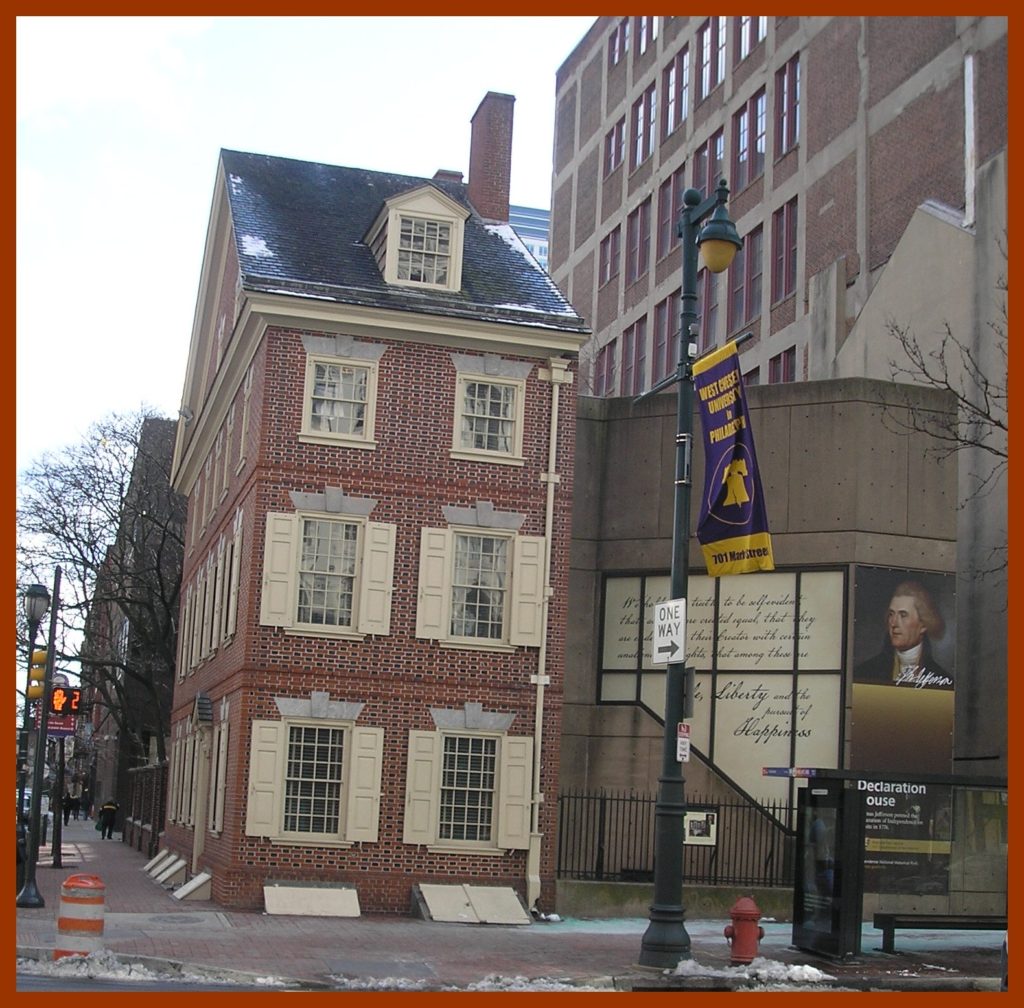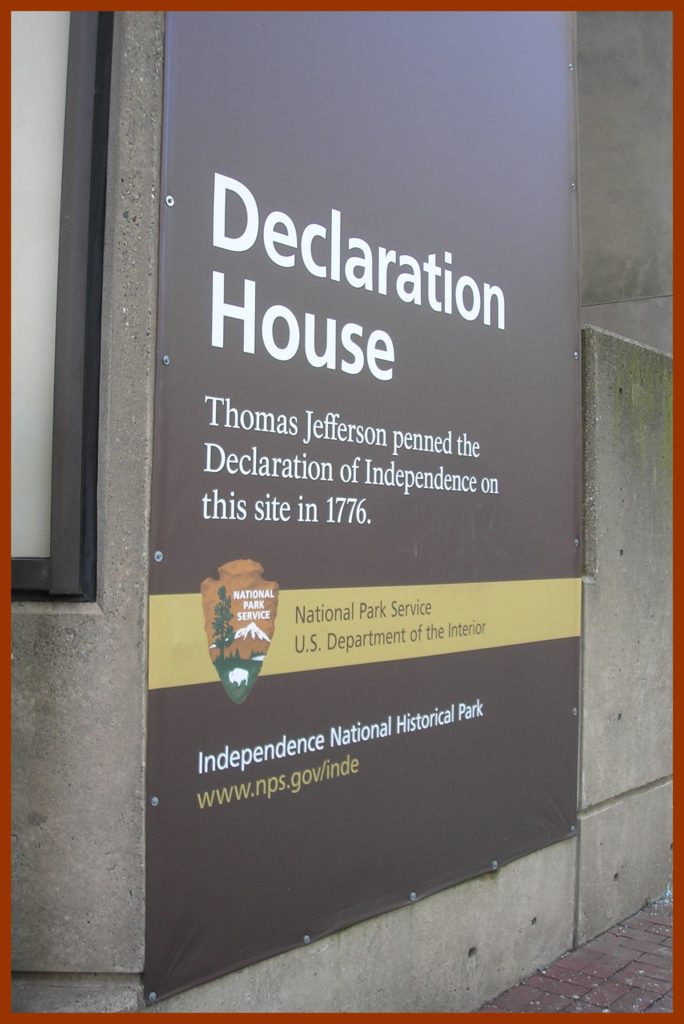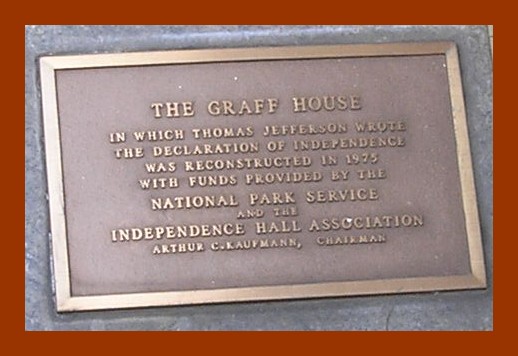When Thomas Jefferson wrote the Declaration of Independence in Philadelphia in 1776, he was renting two rooms in the home of Jacob Graff, at the location of 7th and Market Streets. In 1798, well after the Declaration and during the Presidency of John Adams, this property was purchased by Simon Gratz and his brother Hyman Gratz to use for their wholesale grocery and export business.
The current picture above is of a reconstruction of the house accomplished for the Bicentennial in 1976. The original house was demolished about 1885 and after 1900 a bank was built on the site.
Somehow, over the years, the Graff family became confused with the Gratz family, and the following story was published in the Gratz Sesquicentennial Book in 1955:
It was on the second floor of the Gratz building that Thomas Jefferson wrote the Declaration of Independence in 1776. Jefferson rented rooms here from the Gratz family for his home during the sessions of the Second Continental Congress. In reply to a letter from Dr. James Mease, Jefferson wrote on September 16, 1825, about ten months before his death, “At the time of writing this document I lodged in the house of Mr. Gratz, a new brick house, three stories high. I rented the second floor. In the parlor I wrote this paper.” By a little stretch of the imagination one can see Simon Gratz, then three years old, frequently annoying the Virginia statesman as he was concentrating on the exact phrasing of the fiery words of the immortal document.building that Thomas Jefferson wrote the Declaration of Independence in 1776. Jefferson rented rooms here from the Gratz family for his home during the sessions of the Second Continental Congress. In reply to a letter from Dr. James Mease, Jefferson wrote on September 16, 1825, about ten months before his death, “At the time of writing this document I lodged in the house of Mr. Gratz, a new brick house, three stories high. I rented the second floor. In the parlor I wrote this paper.
By a little stretch of the imagination one can see Simon Gratz, then three years old, frequently annoying the Virginia statesman as he was concentrating on the exact phrasing of the fiery words of the immortal document.
While the Gratz family did own several buildings in old Philadelphia, this was not one of them in 1776.
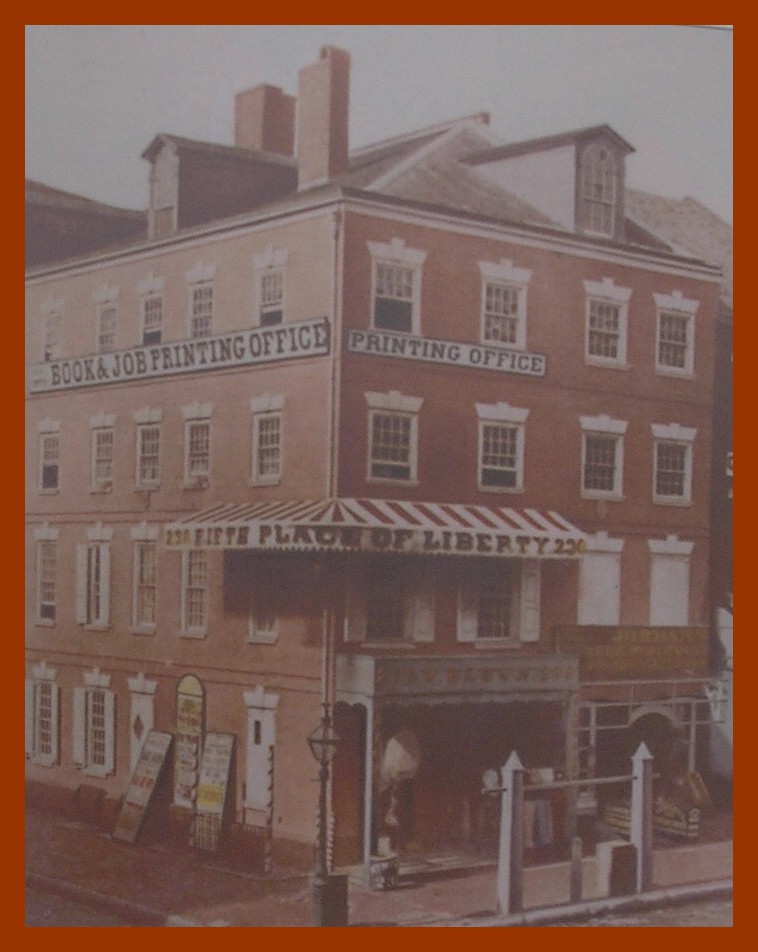
The corner brick building took on a different look during the time of ownership by Simon Gratz and his brother Hyman Gratz. The above picture appears on one of the story-boards outside the reproduction building along with the following caption:
The Gratz family owned the building through much of the 1800s. They made many modifications to the original home. In 1883, the building was torn down.
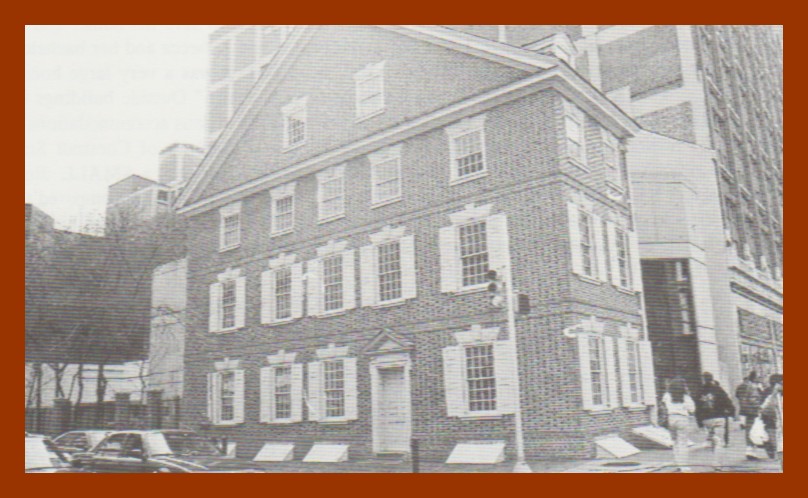
The above photo was published in the Gratz history of 1997. That book attempted to correct the legend. But did it?
It was a three building complex, beginning at the southwest corner of Seventh and Market Streets. The Gratz family purchased first, a building located next to the corner property. In 1798, Simon Gratz and Hyman Gratz bought the old red brick corner property, and remodeled it for their wholesale grocery and export business. Simon Gratz and Hyman Gratz later purchased the third adjoining house. The Gratz business establishment was large and extensive, bringing much wealth to the brothers. Over the years their commercial operations expanded, and they became still greater factors in diverse areas of Philadelphia….
The buildings which housed the Gratz enterprises survived until shortly after 1900, when Penn National Bank was built on the site. The corner building is notable because because within it’s [sic] walls, the Declaration of Independence had been penned by Thomas Jefferson in the spring of 1776. Mr. Jefferson boarded in this building during the sessions of the Continental Congress. After the Revolution, Judge James Wilson, himself a signer of the Declaration of Independence and an Associate Justice of the United States Supreme Court, also occupied this house. The building was demolished in 1884.
A controversy later developed concerning the corner building, but much research eventually revealed the above information to be authentic. In 1961, the National Part Service installed a marker to indicate the significance of the site. in 1865, Albert M. Greenfield, head of the Committee of 1976, waged a campaign to raise funds to build a replica of this house, to be used as a museum. The Federal Government purchased the corner property for $200,000 in 1965. The house was built, and has become a museum which is open to the public….
The paragraphs in the Gratz history do not identify the “controversy.” The controversy was created and/or extended by the incorrect information published in the prior Gratz history which was published by the precursor group (Sesquicentennial Committee), of the historical society that created the 1997 history. The basic problem is that the wrong family was identified as owning the house when Jefferson rented the rooms.
It is not known at the time of this blog-post-writing who originally told the false story that it was the Gratz family that owned and lived in the house in July 1776. The Gratz family owned and used the property as a business at a later time. But, the historical record is clear: at the time of the writing of the Declaration, the house was owned by the Graff family!
Today, a large sign on Market Street next to the reconstructed house indicates that this is the “Declaration House” where “Thomas Jefferson penned the Declaration of Independence on this site in 1776.”
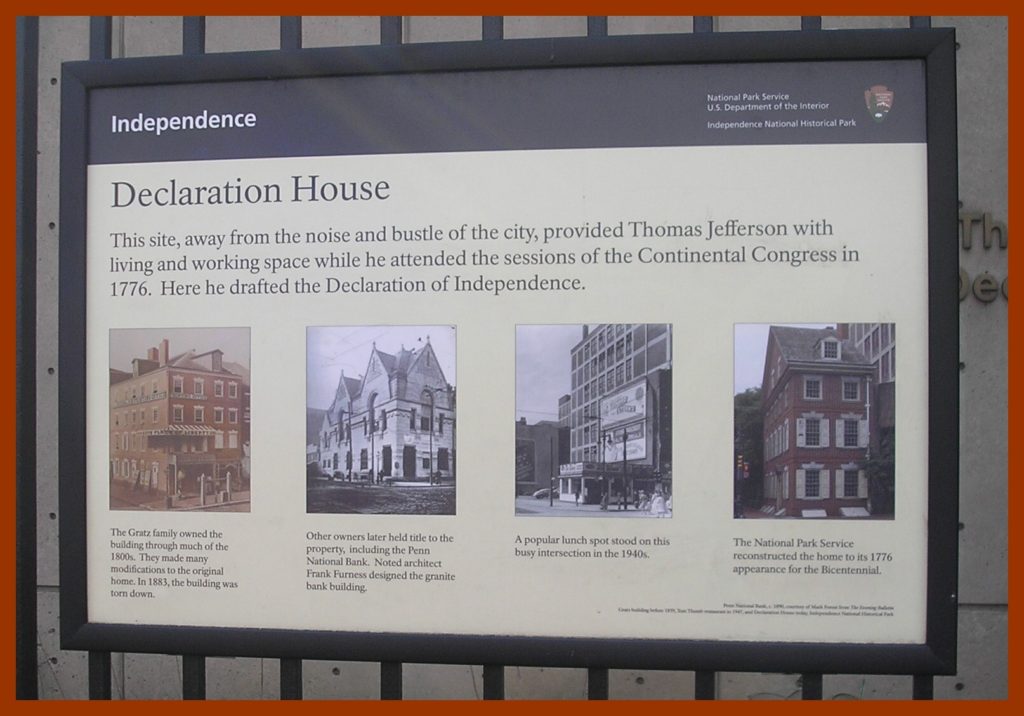
On the fence for the rear yard of the property is a story board telling some of the history of the site:
This site, away from the noise and bustle of the city, provided Thomas Jefferson with living and working space while he attended the sessions of the Continental Congress in 1776. Here he drafted the Declaration of Independence.
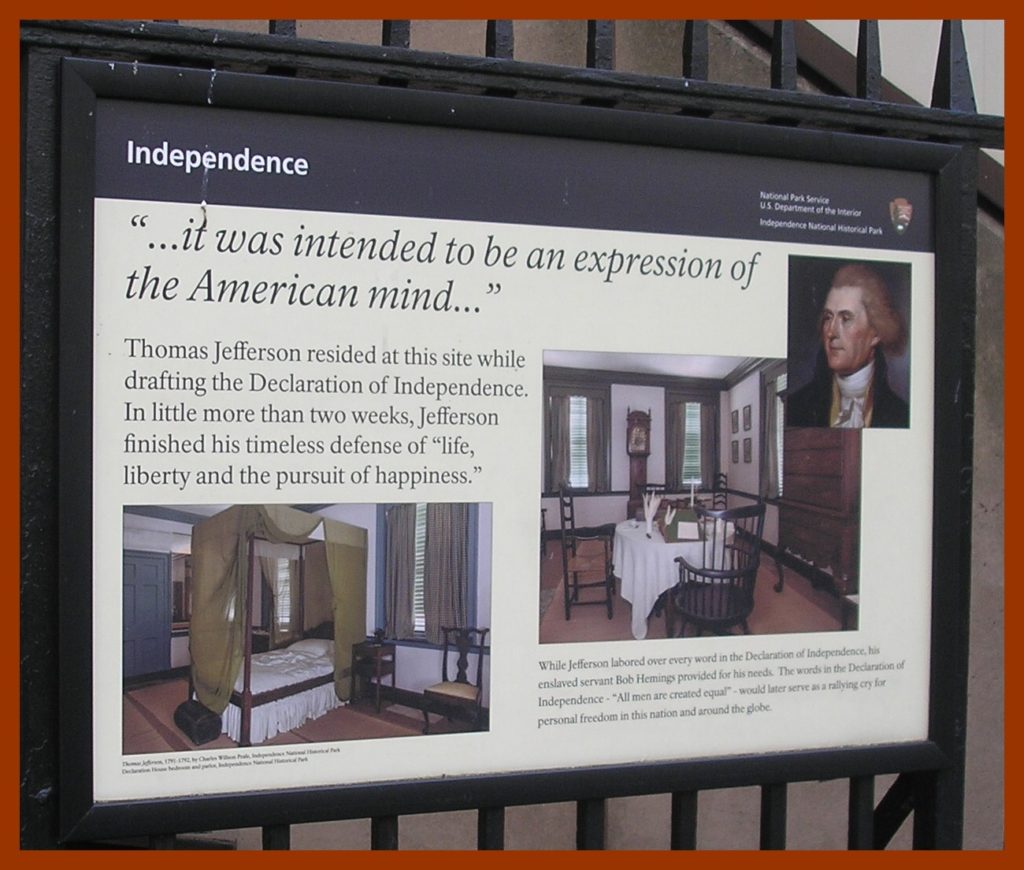
A second story board shows two interior views of the house and states:
“… it was intended to be an an expression of the American mind…”
Thomas Jefferson resided at this site while drafting the Declaration of Independence. In little more than two weeks, Jefferson finished his timeless defense of “life, liberty and the pursuit of happiness.”
Finally, a bronze plaque sits just outside the rear door. On it is inscribed:
THE GRAFF HOUSE
IN WHICH THOMAS JEFFERSON WROTE THE DECLARATION OF INDEPENDENCE. WAS RECONSTRUCTED IN 1975 WITH FUNDS PROVIDED BY THE
NATIONAL PARK SERVICE
and the
INDEPENDENCE HALL ASSOCIATION
ARTHUR C. KAUFMANN, CHAIRMAN
____________________________________
Corrections and additional information should be added as comments to this post.
